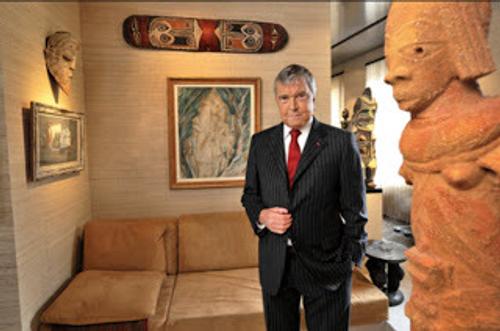Barbier Pre-Columbian Sale - Sotheby's Paris
- October 22, 2013 19:58

PARIS: The sale is now over in Paris and is it is now obvious that the French Government never had any intention of stopping the sale. Considering that many objects had a pretty solid collection history and considering the fact that many had been in the public sector for at least fifteen years while exhibited in the museum in Barcelona, this position is pretty defensible. Never had a single owner sale with this quality and this collection history been offered at a public sale. So this certainly was a very big target for these countries and those individuals that feel all indigenous art belongs in the country of origin. It certainly appeared that the eight countries lodging protests were communicating with one another to maximize their impact on the international art world. So this possible cooperation alone is another unique aspect that makes this sale a historical event.
I watched every lot as it was offered and as I have already pointed out there were unique aspects in both Sothebys presentation and the owner's implied participation. Strategically the catalog was not written with lots presented geographically. Almost all the top lots were included in session two which was the Friday night that followed literally 50 minutes after the afternoon session ended. Again based on the historical track record of what works in auction catalogs, this didn't even make sense. And in retrospect the high percentage of bought in lots might argue that something didn't work. Nobody is going to accuse anyone of incompetence or bad judgment. So be assured we won't know with certainty what happened. But based on my experience of looking at these sales for almost forty years, let me speculate. And in this case speculation is good because if I'm right there is something to learn from what happened. Admittedly I'm guessing but I believe Sothebys didn't set the estimates or reserves. I am also betting that Jean Paul Barbier negotiated a no sellers commission with all expenses paid by Sothebys. Finally I don't believe Sothebys designed that catalog without significant input from the owner.
Seemingly everyone with an agenda will claim victory, but that certainly is to be expected to influence the marketplace. This sale brought in about 13 million dollars which admittedly was much lower than the expected $20 million this sale was supposed to bring. The Pre-Columbian countries will claim their protests and implicit threats of legal action severely impacted the bidding. While that may be partially true especially considering institutional bidding that didn't happen, that certainly isn't the entire story. I think dealers, curators and collectors to include the public sector were offended by the estimates and reserves and dropped out before the first lot went up. Generally the auction house tries to get the bidding at least started in an effort to build momentum. On many lots Sothebys never even got a bid. I do believe that the auction house attracted bidders outside the Pre-Columbian field which helped a great deal. Clearly this sale was targeted in a way that enabled the Pre-Columbian countries to make a statement. Ironically, approaching this sale with a club and beating Sothebys over the head might not have been the best strategy to recover what they state is their national patrimony. The marketplace always seeks the avenue of least resistance and that will be private sales which will be far more difficult and expensive to track.
Other sales effected by protests this year was Sothebys May tribal art sale in New York, which included Pre-Columbian, and the April Pre-Columbian Sale at the Binoche- Giquello auction house based.





















